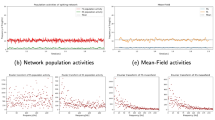We have analyzed the presence of persistence properties in rabbit brain electrical signals by means of non-equilibrium statistical physics tools. To measure long-memory properties of these experimental signals, we have first determined whether the data are fractional Gaussian noise (fGn) or fractional Brownian motion (fBm) by calculating the slope of the power spectral density plot of the series. The results show that the series correspond to fBm. Then, the data were studied by means of the bridge detrended scaled windowed variance analysis, detecting long-term correlation. Three different types of experimental signals have been studied: neural basal activity without stimulation, the response induced by a single flash light stimulus and the average of the activity evoked by 200 flash light stimulations. Analysis of the series revealed the existence of persistent behavior in all cases. Moreover, the results also exhibited an increasing correlation in the level of long-term memory from recordings without stimulation, to one sweep recording or 200 sweeps averaged recordings. Thus, brain neural electrical activity is affected not only by its most recent states, but also by previous states much more distant in the past.



Similar content being viewed by others
REFERENCES
Allegrini, P., M. Buiatti, P. Grigolini, and B. J. West. Fractal brownian motion as non-stationary process: An alternative paradigm for DNA sequences. Phys. Rev. E 57:4558–4562, 1988.
Anderson, C. M., A. J. Mandell, and K. A. Selz, L. M. Terry, C. H. Wong, S. R. Robinson, S. S. Robertson, and W. P. Smotherman. The development of nuchal atonia associated with active (REM) sleep in fetal sheep: Presence of recurrent fractal organization. Brain Res. 787:351–357, 1988.
Arezzo, J. C., C. F. Brosnan, C. E. Schroeder, M. S. Litwak, and M. B. Bornstein. Electrophysiological analysis of factors involved in the primary demyelinating diseases: the rabbit eye model system. Brain Res. 462:286–300, 1988.
Bassingthwaighte, J. B., and G. M. Raymond. Evaluation of the dispersional analysis method for fractal time series. Ann. Biomed. Eng. 23:491–505, 1995.
Bershadskii, A., E. Dremencov, D. Fukayama and G. Yadid. Self-Averaging in Complex Brain Neuron Signals Eur. Phys. J. B 30(4):581–585, 2002.
Caccia, D. C., D. B. Percival, M. J. Cannon, G. M. Raymond, and J. B. Bassingthwaighte. Analyzing exact fractal time series: evaluating dispersional analysis and rescaled range methods. Physica A 246:609–632, 1997.
Cannon, M. J., D. B. Percival, D. C. Caccia, G. M. Raymond, and J. B. Bassingthwaighte. Evaluating scaled windowed variance methods for estimating the Hurst coefficient of time series. Physica A 241:606–626, 1997.
Eke, A., P. Herman, L. Kocsis, and L. R. Kozak. Fractal characterization of complexity in temporal physiological signals. Physiol. Measure 23:R1–R38, 2002.
Flandrin, P. On the spectrum of fractal brownian motions. IEEE Trans. Inform. Theory 35:197–199, 1989.
Halliday, A. M. The comparative value of the different evoked potentials and other paraclinical tests in the diagnosis and prognosis of demyelinating disease. In: Evoked potentials in clinical testing, edited by A. M. Halliday. Edinburgh: Churchill-Livingstone, pp. 467–488, 1993.
Halliday, A. M. The visual evoked potentials in the investigation of diseases of the optic nerve. In: Evoked potentials in clinical testing, edited by A. M. Halliday. Edinburgh: Churchill-Livingstone, pp 195–278, 1993.
Iyengar, N., C. K. Peng, R. Morin, A. L. Goldberger, and L. A. Lipsitz. Age-related alterations in the fractal scaling of cardiac interbeat interval dynamics. Am. J. Physiol. 271:R1078–R1084, 1996.
Kriss, A. Recording technique. In: Evoked potentials in clinical testing, edited by A. M. Halliday. Edinburgh: Churchill-Livingstone, 1993, pp. 1–56.
Liebovitch, L. S., A. T. Todorov, M. Zochowski, D. Scheurle, L. Colgin, M. A. Wood, K. A. Ellenbogen, J. M. Herre, and R. C. Bernstein. Nonlinear properties of cardiac rhythm abnormalities. Phys. Rev. E 59(3):3312–3319, 1999.
Lowen, S. B., L. S. Liebovitch, and J. A. White. Fractal ion-channel behavior generates fractal firing patterns in neuronal models. Phys. Rev. E 59(5):5970–5980, 1999.
Mahasweta, D., G. L. Gebber, S. M. Barman, and C. D. Lewis. Fractal Properties of Sympathetic Nerve Discharge. J. Neurophysiol. 89:833–840, 2003.
Raymond, G. M., D. B. Percival, and J. B. Bassingthwaighte. The spectra and periodograms of anti-correlated discrete fractional Gaussian noise. Physica A 322:169–179, 2003.
Rosner, B. Fundamentals of Biostatistics, 4th ed. Belmont: Duxbury Press, 1995.
Schlag, J. Generation of Brain Evoked Potentials. In: Bioelectric Recording Techniques, Part A: Cellular Processes and Brain Potentials, edited by R. F. Thompson and M. M. Patterson. New York: Academic Press, 1973, pp. 263–299.
Soto, A., A. L. Pérez-Samartín, E. Etxebarria, and C. Matute. Exitotoxic insults to the optic nerve alter visual evoked potentials. Neuroscience 123:441–449, 2004.
Viswanathan, G. M., S. V. Buldyrev, S. Havlin, and H. E. Stanley. Quantification of DNA patchiness using long-range correlation measures. Biophys J. 72:866–875, 1997.
Yulmetyev, R., R. P. Hänggi, and F. Gafarov. Stochastic processes of demarkovization and markovization in chaotic signals of the human brain electric activity from EEGs at epilepsy. JETP 123(3):1–6, 2003.
ACKNOWLEDGMENTS
This work has been supported by the Grant Nos. MC y T BFM2001-0201, UPV 13665/2001, UPV 00127.312-E-15280/2003, FISS PI041234, MTM 2005-01504 and SAF 2004-06949. The authors appreciate the valuable help of I. Arostegui and also express their thanks to the agency ACTS (Academic Consulting and Translating Services; http://www.euskalnet.net/acts) for having improved the English of this paper.
Author information
Authors and Affiliations
Corresponding author
Rights and permissions
About this article
Cite this article
de la Fuente, I.M., Perez-Samartin, A.L., Martínez, L. et al. Long-Range Correlations in Rabbit Brain Neural Activity. Ann Biomed Eng 34, 295–299 (2006). https://doi.org/10.1007/s10439-005-9026-z
Received:
Accepted:
Published:
Issue Date:
DOI: https://doi.org/10.1007/s10439-005-9026-z




